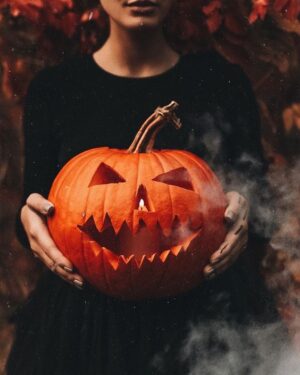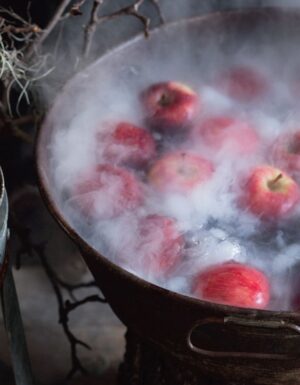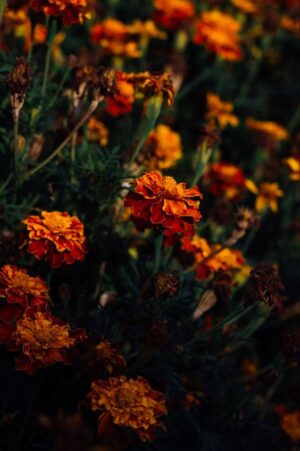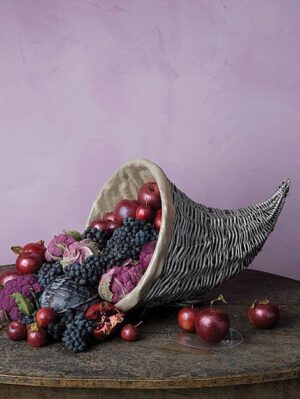Today we’re covering the top 12 Samhain symbols to use in your rituals this year!
As the leaves begin to transform into vibrant hues and a crisp chill fills the air, the ancient festival of Samhain draws near. Samhain, pronounced “sow-in,” marks the Celtic New Year and is celebrated on October 31st.
This sacred holiday holds deep significance for many modern-day practitioners of various pagan and earth-based spiritual traditions. It’s a time to honor our ancestors, connect with the spirit world, and embrace the cycle of life, death, and rebirth.
One of the beautiful aspects of Samhain is the rich tapestry of Samhain symbols associated with the holiday. These Samhain symbols hold profound meanings and can add depth and intention to your Samhain rituals and celebrations.
In this blog post, we’ll explore twelve Samhain symbols that you can incorporate into your practice this October.
12. Jack-O’-Lanterns

The flickering glow of a Jack-O’-Lantern is a quintessential image of the Halloween season, but its origins and significance trace back to the ancient Celtic festival of Samhain. With a history rooted in folklore, mythology, and modern-day traditions, the Jack-O’-Lantern has evolved into a powerful symbol of protection, guidance, and connection to the spirit world.
The tale of the Jack-O’-Lantern finds its origins in Irish folklore and the legend of “Stingy Jack.” According to the story, Stingy Jack was a clever yet deceitful man who managed to trick the devil on multiple occasions. However, when he died, neither heaven nor hell would accept his soul due to his duplicitous nature.
Left to wander the darkness between worlds, Stingy Jack was given only a burning coal by the devil, which he placed inside a carved-out turnip to serve as a lantern to light his eternal path. The turnip was illuminated from within by the ember, creating a ghostly and eerie light. The Irish began carving their own turnips and potatoes to ward off wandering spirits and to remember Stingy Jack’s fate.
When Irish immigrants brought this tradition to America, they discovered that pumpkins, native to the New World, made for excellent carving due to their size and availability. The tradition of carving pumpkins into Jack-O’-Lanterns was born, preserving the essence of the ancient tale while adapting to new materials.
In modern times, the Jack-O’-Lantern has taken on multifaceted Samhain symbolism, especially during the Samhain season. Here are some of the ways the Jack-O’-Lantern is incorporated into contemporary practices:
Protection and Warding: Just as the original Jack-O’-Lantern was said to ward off evil spirits and protect homes, modern practitioners often carve Jack-O’-Lanterns as a means of safeguarding their spaces during the Samhain season. Placing a lit Jack-O’-Lantern on one’s doorstep or windowsill is believed to provide a protective barrier against negative energies and unwanted spirits.
Guidance for Ancestors: The warm, inviting light of a Jack-O’-Lantern can serve as a beacon to guide ancestral spirits back to the realm of the living. As practitioners create illuminated pathways with Jack-O’-Lanterns, they invite their ancestors to visit and partake in Samhain festivities, ensuring their presence and blessings are felt during this sacred time.
Honoring the Dead: Through the act of carving and lighting Jack-O’-Lanterns, individuals can pay homage to their deceased loved ones. By placing these illuminated creations on altars or gravesites, practitioners create a visible link between the realms, fostering a connection between the living and the departed.
Celebration of Transformation: Samhain is a festival of transformation, marking the end of the harvest season and the beginning of winter. The act of carving a Jack-O’-Lantern embodies the concept of transformation, as a simple pumpkin is turned into a radiant symbol of light. This transformation is a reminder of the cyclical nature of life, death, and rebirth.
Community and Tradition: Carving Jack-O’-Lanterns is a popular and communal activity during the fall season. Families and friends come together to create intricate designs, share stories, and celebrate their shared connections. This sense of community mirrors the communal gatherings of ancient Samhain celebrations, fostering a sense of belonging and unity.
11. Bonfires

The use of bonfires as part of seasonal celebrations dates back centuries, with the Celtic festival of Samhain being no exception. Samhain, which marks the end of the harvest season and the beginning of winter, was a time of great importance to the ancient Celts. Bonfires were lit to both honor the gods and goddesses and to ward off malevolent spirits that were believed to roam freely as the veil between the physical and spiritual worlds grew thin.
In Celtic communities, villagers would come together to kindle these massive fires using sacred woods and offerings. People would often bring offerings of food and livestock to be sacrificed in the flames, a practice believed to ensure a bountiful harvest in the following year. These fires served as a communal gathering point, where stories were shared, rituals were performed, and a sense of unity was reinforced.
The bonfire is rich with Samhain symbolism, embodying concepts that remain relevant in contemporary Samhain celebrations:
Transformation and Renewal: The bonfire is a representation of the transformative power of fire. Just as the flames consume wood and turn it to ash, the bonfire symbolizes the cycle of death and rebirth, echoing the overarching theme of Samhain as a festival that acknowledges the transition from one season to another.
Purification and Release: The flames of the bonfire are believed to purify and cleanse the energies of a space. In modern practices, individuals may write down negative thoughts, habits, or experiences on pieces of paper and cast them into the fire, symbolically releasing these burdens and allowing them to be transformed.
Protection and Warding: Bonfires are thought to provide protection against malevolent forces. Their radiant light is said to drive away negative energies and keep harmful spirits at bay, making the surrounding area a safe and sacred space for rituals and gatherings.
Threshold between Worlds: Just as the bonfires illuminated the physical world, they also acted as a symbolic bridge between the realm of the living and the realm of the ancestors and spirits. In this liminal space, practitioners could communicate with the spirit world and honor their ancestors.
Community and Connection: Like the bonfires of old, modern-day bonfire celebrations continue to foster a sense of community and togetherness. People gather around the flames to share stories, sing songs, and strengthen their bonds with one another, echoing the communal spirit of the ancient Samhain festivities.
While traditional bonfires may not always be practical for modern living situations, you can still incorporate the bonfire’s symbolism into your Samhain celebrations:
Candlelit Rituals: Create a smaller-scale “bonfire” by lighting a circle of candles. As you light each candle, reflect on its Samhain symbolism and invite its energy into your ritual.
Fire Pit Ceremonies: If you have access to a fire pit, gather friends or family for a bonfire-inspired ceremony. Share stories, make offerings, and perform rituals around the fire.
Bonfire Imagery: Decorate your space with images of bonfires, or use bonfire-themed decorations to evoke the Samhain symbolism and energy of the flames.
Meditation and Reflection: Sit before a real or imagined bonfire and meditate on the themes it represents: transformation, release, protection, and connection. This is especially potent if done under the Harvest Moon.
10. Apples

Amidst the kaleidoscope of colors that paint the landscape during the fall season, the humble apple stands as a cherished symbol with deep-rooted significance in Samhain celebrations. From divination rituals to ancestral offerings, the apple’s role in Samhain traditions bridges the gap between the physical and spiritual realms, intertwining themes of knowledge, transformation, and connection to the past.
In Celtic mythology, the apple held a special place as a symbol of immortality, healing, and wisdom. It was associated with the Otherworld, a realm beyond the ordinary reality where the spirits of the dead resided. The Otherworld was believed to be accessible during Samhain, when the veil between the worlds was at its thinnest. Apples were often used as offerings to appease and honor the spirits, ensuring their blessings and protection for the upcoming winter months.
One of the most well-known legends involving apples is the story of Avalon, a mythical island in Arthurian lore. Avalon was often associated with apples and was a place of eternal youth and healing. This connection further solidified the apple’s role as a potent symbol of the afterlife and mystical realms.
Apples have been a staple of Samhain divination rituals for centuries. One of the most popular practices involves “apple bobbing,” where individuals try to catch an apple with their teeth from a basin of water. The first person to do so would be the next to marry or experience good fortune in the coming year. The act of plunging one’s face into water to retrieve an apple was believed to symbolize a journey into the Otherworld and the acquisition of hidden knowledge.
The apple’s symbolic associations extend to the concept of knowledge and self-discovery. In Norse mythology, the goddess Iðunn guarded apples that granted the gods eternal youth and wisdom. Similarly, the biblical story of Adam and Eve involves the consumption of the “forbidden fruit” – often depicted as an apple – leading to a profound shift in human consciousness and the gaining of knowledge.
In modern Samhain celebrations, apples continue to play a significant role:
Offerings and Ancestral Connections: Placing apples on altars or outdoor shrines can serve as offerings to honor and connect with ancestors. The fruit is seen as a gesture of respect and a means of inviting their presence into the Samhain festivities.
Divination and Insights: Engaging in apple-related divination rituals, such as apple bobbing or peeling, can provide insights and guidance from the spirit realm. Pay attention to patterns and shapes that emerge during these practices, as they may hold messages from beyond.
Feasting and Celebration: Apples are often incorporated into Samhain feasts and recipes, celebrating the abundance of the harvest season. Apple dishes can serve as a way to ground the celebration in the physical world while maintaining a connection to the spiritual Samhain symbolism of the fruit.
Altar Decorations: Including apples in your Samhain altar setup can infuse your sacred space with the fruit’s energy, symbolizing the cyclical nature of life and death and the continuity of ancestral wisdom.
9. Marigolds

These golden blooms, often associated with the “Day of the Dead” celebrations in Mexico, have transcended cultural boundaries to become one of the cherished Samhain symbols. With their radiant hues and profound meanings, marigolds play a role in honoring ancestors, guiding spirits, and embracing the cycle of life, death, and rebirth.
The connection between marigolds and death goes back centuries, and it’s not limited to Samhain symbols and celebrations. In Mexican culture, marigolds are a central element of Dia de los Muertos (Day of the Dead) festivities. During this holiday, families create ofrendas (altars) adorned with marigold petals to guide the spirits of the departed back to the world of the living. The vibrant colors and strong scent of marigolds are believed to attract and guide these spirits, ensuring they can find their way home.
Marigolds bring layers of symbolism to Samhain practices, enhancing the atmosphere of remembrance and transition:
Ancestral Connections: Just as marigolds guide spirits in Mexican traditions, these vibrant flowers are believed to attract and honor the presence of ancestors during Samhain. Placing marigold petals on altars or creating garlands can serve as a gesture of inviting ancestral spirits to join in the celebrations and offering them a path to connect with the living.
The Cycle of Life and Death: Marigolds are annual flowers, blooming and wilting within a single growing season. This transient nature mirrors the cyclical themes of Samhain, where the end of the harvest season marks the transition from life to death, and ultimately to rebirth. Incorporating marigolds into Samhain rituals reminds practitioners of the interconnectedness of these cycles.
Guiding and Illuminating: The bright and sunny hues of marigolds are thought to provide a guiding light for spirits as they traverse between the realms. Their vibrant colors pierce through the darkness, symbolizing the hope and guidance that ancestral spirits can offer as they make their journey to visit the living.
Celebration of Life: While Samhain is a time to honor the dead, it’s also a celebration of life. Marigolds, with their cheerful colors, remind us to embrace the joy and vitality of the present moment while acknowledging the inevitability of transition and change.
Incorporating marigolds into your Samhain celebrations allows you to infuse your rituals with their vibrant energy:
Altar Decor: Use marigold petals to create stunning and fragrant altar decorations. Arrange them around candles, crystals, and other symbolic items to enhance the visual appeal and energy of your sacred space.
Offerings: Place marigold blooms or petals as offerings on your ancestral altar, expressing your intention to connect with and honor your ancestors during the Samhain season.
Garlands and Wreaths: Craft garlands or wreaths using marigold blooms. Hang them in doorways or around your home to welcome and guide ancestral spirits.
Meditation and Reflection: During meditation or reflection, hold marigold petals in your hands and visualize a warm and inviting light. Envision this light as a bridge between the realms, allowing you to connect with the energy and wisdom of your ancestors.
8. Mums

Chrysanthemums, commonly known as mums, stand as vivid and enchanting Samhain symbols deeply intertwined with the spirit of Samhain. These radiant flowers, with their rich history and multifaceted meanings, embody themes of death, rebirth, transformation, and the cyclical nature of existence.
Chrysanthemums have held special significance in various cultures and traditions around the world. In East Asia, particularly in China and Japan, chrysanthemums have been revered for centuries and are often associated with longevity, nobility, and purity. In Japan, the “Festival of Happiness” or “Festival of Chrysanthemums” (Kiku Matsuri) celebrates the beauty of these flowers.
In the context of Samhain, mums take on additional layers of Samhain symbolism, resonating with themes central to this sacred season.
Mums bring a rich tapestry of symbolism to Samhain practices, inviting contemplation and connection:
Death and Rebirth: Mums’ association with autumn and their resilient ability to bloom during this season mirrors the cyclical journey of life, death, and rebirth. Just as mums bloom amid the fading of summer, they symbolize the potential for transformation and new beginnings that emerge from the darkness of the unknown.
The Thin Veil: During Samhain, the boundary between the physical and spiritual realms is believed to be thin. Mums’ delicate petals and ethereal beauty reflect this permeable veil, inviting a sense of connection with the spirit world and facilitating communication with ancestors.
Ancestral Honoring: Incorporating mums into Samhain celebrations serves as a gesture of remembrance and honor for the ancestors. These blooms can be used as offerings on altars, symbolizing the deep connection between the living and those who have crossed over.
Protection and Guidance: Mums’ vibrant colors and intricate layers are believed to attract positive energy and protect against negative influences. Placing mums around your sacred space during Samhain rituals can create an environment of safety and guidance for both the living and the spirits.
7. Witch’s Broom

Among the mystical Samhain symbols that grace the landscape of Samhain traditions, the witch’s broom, or besom, emerges as a powerful and multifaceted emblem. With roots that stretch back through history, folklore, and modern practice, the witch’s broom holds deep Samhain symbolism representing not only the practical aspects of magic but also the liminal spaces between worlds and the transformative power of ritual.
The image of the witch astride a broomstick has been a staple of witchcraft lore for centuries. While the notion of witches flying on broomsticks is often associated with mythology and superstition, the besom has far more to offer in Samhain symbolism and significance.
The besom’s history intertwines with practical and spiritual applications. Historically, brooms were used for sweeping and cleaning, not just of physical spaces but also to energetically cleanse an area of negative or stagnant energies. In pagan and folk traditions, the besom was considered a tool for creating sacred spaces, as well as for “sweeping” away unwanted influences.
The witch’s broom is laden with Samhain symbolism that resonates strongly with the themes of Samhain:
Cleansing and Purification: In a ritual context, the broom is a symbol of purification and cleansing. Just as brooms were used to sweep away physical dirt, they were also believed to sweep away negative energies, preparing the space for magical work or spiritual connection.
Thresholds and In-Between Spaces: The broom holds a special connection to thresholds and liminal spaces. Its long handle represents a bridge between the physical and spiritual worlds, making it a powerful tool for working in these intermediate realms. During Samhain, when the veil between worlds is believed to be thin, the besom can facilitate communication with the spirit world.
Protection and Warding: In folklore, brooms were sometimes placed by doorways or windows to protect against unwanted spirits or energies. By hanging a besom over the entrance, it was believed that negative entities would be deterred or unable to enter.
Ritual and Transformation: The act of physically sweeping with a broom can be seen as a symbolic act of sweeping away the old to make way for the new. This theme aligns with the transformative nature of Samhain, as it marks the end of the harvest season and the beginning of winter—a time of reflection, release, and preparation for rebirth.
Incorporating the Witch’s Broom into Modern Practice:
The besom’s symbolism can enrich your Samhain rituals and practices:
Cleansing Rituals: Use a besom to energetically cleanse your ritual space before Samhain celebrations, removing any unwanted energies and creating a sacred environment.
Ancestral Communication: Incorporate the besom into your rituals for connecting with ancestors. As you hold the broom, visualize it as a tool that can help you cross the threshold between worlds and communicate with the spirit realm.
Creating Sacred Space: Place a besom near your altar or ritual area to symbolize the creation of a sacred and protected space. This can enhance your connection with the spirit world and facilitate any divination or communication work you undertake during Samhain.
Decorative Symbolism: Display an artistic representation of a witch’s broom as part of your Samhain decorations. This can serve as a reminder of the besom’s significance and help set the tone for your celebrations.
You can buy a witch’s broom online or make your own as a Samhain activity.
6. Cornucopia

Amidst the tapestry of Samhain symbols, the cornucopia, often referred to as the “Horn of Plenty,” stands as a powerful emblem of abundance, gratitude, and the cyclical nature of life. This iconic symbol, overflowing with the bounties of the harvest season, carries within it a timeless message of appreciation for the earth’s gifts and a reminder of the interconnectedness of all living things.
The cornucopia has ancient roots that extend beyond Samhain and into various cultures and mythologies. In Greek mythology, the cornucopia is linked to the tale of Amalthea, a goat who nurtured and fed the infant Zeus. As a gesture of gratitude, Zeus blessed Amalthea by transforming her horn into a magical vessel that would always overflow with nourishment and abundance. It also has links to Pluto, the Roman god of the dead, and many other deities of the harvest.
Over time, the cornucopia became a symbol of prosperity, fertility, and the generosity of nature. It found its way into different cultural traditions, including the Roman celebration of Saturnalia, where it was filled with fruits, grains, and other offerings.
The cornucopia carries profound symbolism that aligns beautifully with the themes of Samhain:
Abundance and Harvest: As a vessel overflowing with the bounty of the earth, the cornucopia represents the abundance of the harvest season. It serves as a visual reminder of the rewards reaped from the year’s toil and the cycle of sowing, growing, and harvesting.
Gratitude and Giving Thanks: The cornucopia encourages the practice of gratitude and thanksgiving. It invites us to reflect on the gifts we have received from the earth and fosters a sense of appreciation for the sustenance and resources that support our lives.
Transition and Renewal: Just as Samhain marks the transition from one season to another, the cornucopia signifies the changing cycles of life. It acknowledges that even as one season comes to an end, the promise of new growth and nourishment lies ahead.
Interconnectedness: The overflowing abundance of the cornucopia symbolizes the interconnected web of life. It reminds us that our well-being is intertwined with the well-being of the natural world, encouraging a sense of stewardship and respect for the earth.
The cornucopia’s symbolism can be integrated into your Samhain celebrations in various ways:
Altar Centerpiece: Create an altar centerpiece using a decorative cornucopia filled with an array of autumnal offerings, such as fruits, nuts, grains, and colorful leaves. This serves as a focal point for your Samhain rituals and meditations.
Gratitude Rituals: During your Samhain celebrations, take time to express gratitude for the blessings in your life. Write down your expressions of gratitude and place them within the cornucopia, symbolizing your intentions to continue nurturing an attitude of appreciation.
Feasting and Offerings: Incorporate the cornucopia into your Samhain feasts, filling it with a variety of seasonal foods. As you enjoy your meal, reflect on the interconnectedness of all life and the abundance that sustains you.
Artistic Representation: Create or display artwork that features the cornucopia, capturing its essence as a symbol of abundance and cyclical renewal.
5. Acorns

One of the simplest Samhain symbols to incorporate is the acorn. In the intricate tapestry of Samhain symbolism, the humble acorn emerges as a potent emblem representing potential, rebirth, and the interconnectedness of life. Laden with layers of meaning that bridge ancient traditions and contemporary practice, the acorn’s significance resonates deeply with the themes of transformation and the cyclical nature of existence during this sacred season.
The acorn’s symbolism traces back to various cultures and mythologies. In Norse mythology, the mighty oak tree was associated with Thor, the god of thunder, and was seen as a sacred tree embodying strength and protection. In Celtic traditions, oaks were considered portals to the Otherworld, where spirits could cross the boundary between realms.
In the context of Samhain, the acorn serves as a microcosm of these mythological connections, encapsulating the power of the oak and its role in facilitating communication between the living and the spirit world.
The acorn carries profound symbolism that harmonizes beautifully with the essence of Samhain:
Potential and Growth: The acorn is a symbol of potential and the promise of growth. It represents the small beginnings from which great things can emerge. Just as the acorn contains the blueprint for a mighty oak tree, Samhain marks the time when new possibilities are incubating within the darkness, preparing to manifest in the coming seasons.
Rebirth and Transformation: As a seed, the acorn embodies the concept of transformation. It requires a period of darkness and dormancy before it can burst forth with new life. Similarly, Samhain is a time of transition and change, where the old makes way for the new, and the cycle of life, death, and rebirth continues.
Nurturing Ancestral Connections: The oak tree, from which the acorn originates, is often associated with ancestors and spirits. The acorn serves as a symbolic link between the physical and spiritual realms, inviting connections with those who have passed on. Placing acorns on altars or using them in rituals can facilitate communication with ancestors and the spirit world.
Strength and Resilience: Despite its small size, the acorn possesses the strength to grow into a mighty oak tree. This resilience is reflected in its symbolism during Samhain, reminding us of the inner strength we carry and the potential for growth and transformation that resides within us.
4. Soul Cakes

Looking for Samhain symbols that are tangible and edible? In the tapestry of Samhain traditions, soul cakes emerge as a unique and meaningful symbol that weaves together themes of remembrance, generosity, and the connection between the living and the departed. These simple yet potent treats hold a place of honor in the festivities, serving as offerings and tokens of goodwill that bridge the gap between this world and the realm of spirits.
Soul cakes have a rich history rooted in medieval European customs. In the Christian tradition, All Souls’ Day was observed on November 2nd to honor and pray for the souls of the departed. It was common for people to go “souling” on this day, visiting homes and receiving small cakes in exchange for prayers for the souls of the household’s deceased loved ones.
Over time, this tradition evolved and intertwined with Samhain practices, blending elements of both Christian and pagan beliefs. Soul cakes became associated with the concept of the “Dumb Supper,” a ritual where a meal was prepared for and shared with the spirits of the departed.
Soul cakes embody layers of symbolism that align beautifully with the essence of Samhain:
Nourishing the Spirit: Just as physical sustenance nourishes the body, soul cakes are seen as nourishment for the spirits. The act of offering and consuming these cakes symbolizes the care and consideration extended to the departed, acknowledging their continued presence and importance.
Honoring Ancestors: Soul cakes serve as a means of honoring and connecting with ancestors. By sharing these treats, individuals express gratitude and remembrance for those who have passed on, maintaining a link between generations and ensuring that their stories and legacy live on.
Threshold Between Worlds: Samhain is a time when the boundary between the physical and spiritual worlds is believed to be thin. Soul cakes serve as a tangible representation of this threshold, acting as offerings that invite ancestral spirits to partake in the celebrations and festivities of the living.
Generosity and Sharing: The act of baking and sharing soul cakes embodies the spirit of generosity and community. This tradition fosters a sense of togetherness and kinship, reminding us of the importance of supporting and caring for one another.
Explore ways to integrate the symbolism of soul cakes into your Samhain observances:
Baking Ritual: Bake soul cakes as part of your Samhain preparations. As you mix the ingredients, infuse them with intentions of remembrance, connection, and the sharing of blessings.
Offerings: Place soul cakes on your ancestral altar as offerings to honor your departed loved ones. Light a candle and express your gratitude for their presence in your life.
Sharing and Community: Share soul cakes with friends, family, or your local community as a way to spread the spirit of togetherness and remembrance during Samhain.
Dumb Supper: If you’re drawn to the tradition of the Dumb Supper, incorporate soul cakes into the meal as a way to nourish and honor the spirits during this solemn and sacred ritual.
3. Scarecrows

While the scarecrow may not be as ancient as some other Samhain symbols, its presence in agricultural and folk traditions has imbued it with rich symbolism that resonates with the essence of Samhain.
The scarecrow’s history can be traced back to agricultural practices, where it was crafted and placed in fields to ward off birds and protect crops from being devoured. Over time, the scarecrow’s role expanded beyond its utilitarian function, becoming a cultural and seasonal emblem associated with the harvest season and the transition from autumn to winter.
The scarecrow carries meaningful symbolism that harmonizes with the themes of Samhain:
Boundary Keeper: In Samhain traditions, the boundary between the physical and spiritual realms is believed to be thin. The scarecrow, positioned at the edges of fields, serves as a symbolic boundary keeper, standing guard between the realms and protecting the harvest from unwanted influences.
Protection and Guardianship: Just as the scarecrow safeguards the crops, it is seen as a guardian of the land and its abundance, one of the most important Samhain symbols in ancient pagan times. During Samhain, when the land’s energy shifts and the natural world prepares for a period of rest, the scarecrow’s presence can offer protection and ensure that the land remains fertile and ready for the coming seasons.
Transition and Reflection: The scarecrow’s role in overseeing the harvest and marking the transition from one season to another mirrors the themes of change and reflection during Samhain. As the last of the crops are gathered, the scarecrow stands as a silent witness to the passage of time and the cyclical nature of life.
Harvest Spirits: In some cultural traditions, scarecrows were believed to embody or attract the spirits of the harvest. During Samhain, when ancestral spirits are honored and remembered, the scarecrow’s presence can symbolize the connection between the spirit world and the earthly realm.
If you resonate with the symbolism of the scarecrow, consider integrating it into your Samhain observances:
Altar Decoration: Create a scarecrow-themed decoration for your Samhain altar or sacred space. This can serve as a visual representation of the boundary between worlds and the protection it offers.
Outdoor Rituals: If you have access to outdoor space, consider incorporating a scarecrow into your Samhain rituals. Use it as a focal point for honoring the spirits of the land and the harvest.
Crafting: Craft a scarecrow figure as part of your Samhain celebrations. As you create it, infuse it with intentions of protection, transition, and connection to the cycles of nature.
Reflection and Meditation: Spend time in meditation or contemplation with an image or representation of a scarecrow. Reflect on its symbolism and how it relates to your own journey of change and growth.
2. Veil Between Worlds

The concept of the veil between worlds emerges as a foundational and enchanting motif, weaving together themes of spirituality, transition, and the profound interconnectedness of existence. As the boundary between the physical and spiritual realms is believed to thin during this sacred season, the veil serves as a gossamer bridge that allows for heightened communication and communion with the spirit world.
This is certainly one of the most important Samhain symbols throughout history.
The symbolism of the veil between worlds is rich and multi-faceted, offering a profound lens through which to understand the essence of Samhain:
Liminal Spaces: Samhain represents a liminal space, a threshold between the old and the new, the living and the departed. The veil between worlds becomes a metaphorical and energetic representation of this in-between state, inviting us to explore the mysteries that dwell within the transition.
Communication with Ancestors: During Samhain, the veil is believed to be at its thinnest, facilitating easier communication with ancestral spirits and guides. The veil acts as a curtain that is drawn aside, allowing for moments of connection, guidance, and remembrance.
Intuition and Insight: As the veil between worlds becomes more translucent, individuals may find their intuitive abilities heightened. Dreams, visions, and insights may be more accessible, providing glimpses into the unseen realms and offering messages from beyond.
Sacred Rituals: The thinning of the veil invites practitioners to engage in sacred rituals, divination, and meditation. It is a time to honor the departed, seek guidance from ancestral spirits, and engage in practices that connect us with the mysteries of existence.
Reverence for Transition: The veil’s symbolism mirrors the natural transitions of life, death, and rebirth. It encourages us to embrace change and honor the cyclical nature of existence, reminding us that even in the darkness, there is the promise of light.
Explore ways to work with the symbolism of the veil between worlds during Samhain:
Divination: Engage in divination practices, such as tarot reading or scrying, to connect with the energies of the season and receive insights from the spirit realm.
Ancestral Honoring: Create an altar dedicated to your ancestors, placing photographs, mementos, and offerings that honor and invite their presence. Use the thinning of the veil to communicate with and seek guidance from those who have passed on.
Meditation and Reflection: Set aside time for meditation and reflection, visualizing the veil between worlds as a translucent curtain. Imagine yourself gently moving through this veil, entering a space where you can commune with spirits and receive messages.
Offerings and Rituals: Light candles, burn incense, and offer food or other symbolic items as offerings to honor the spirits during Samhain rituals. Speak words of remembrance and gratitude, inviting the presence of departed loved ones.
1. Cauldron

As a vessel of ancient wisdom and potent magic, the cauldron carries profound significance during this sacred season, inviting us to explore the depths of our inner selves and embrace the mysteries of life, death, and rebirth.
The cauldron holds a storied history in various cultures and mythologies. In Celtic lore, the cauldron was a sacred symbol associated with the goddess Cerridwen, who brewed a transformative potion granting wisdom and poetic inspiration. This concept of brewing potent elixirs mirrors the transformative energies of Samhain, where the old is released and the new is conceived.
The symbolism of the cauldron is as profound as the mysteries it evokes, intertwining seamlessly with the essence of Samhain:
Transformation and Renewal: The cauldron represents the alchemical process of transformation, wherein raw materials are combined, undergo change, and emerge anew, which is one of the most important Samhain symbols. Just as the cauldron facilitates the metamorphosis of substances, Samhain marks a time of personal and spiritual transformation, allowing us to release what no longer serves us and embrace renewal.
Portal to the Underworld: In myth and folklore, cauldrons were often associated with the Otherworld, serving as portals between realms, another one of the top symbols of Samhain. During Samhain, when the veil between worlds is thin, the cauldron can symbolize the doorway through which we commune with spirits and ancestors, seeking their guidance and wisdom.
Ancestral Connection: The cauldron’s role in brewing and nourishing aligns with the tradition of preparing offerings for ancestral spirits. It becomes a vessel for offerings, allowing us to connect with and honor our departed loved ones.
Cycles of Life and Death: The cauldron’s cyclical nature, wherein ingredients are transformed and renewed, mirrors the cyclical themes of Samhain. It embodies the journey of life, death, and rebirth, reminding us that endings are intertwined with beginnings.
Embrace the cauldron’s symbolism in your Samhain rituals and celebrations:
Altar Centerpiece: Place a cauldron as a centerpiece on your Samhain altar, surrounded by candles, crystals, and other Samhain symbols of the season. This creates a focal point for transformative rituals.
Ancestral Offerings: Use a cauldron to hold offerings for your ancestors. Fill it with food, drink, or symbolic items that hold significance for your departed loved ones, or even other Samhain symbols like acorns or apples.
Scrying and Divination: Incorporate scrying—a form of divination—by filling the cauldron with water and gazing into its depths. This practice can facilitate insights and connections with the spirit realm.
Ritual of Release: Write down aspects of your life that you wish to release, whether habits, emotions, or situations. Safely burn these slips of paper in the cauldron, symbolizing their transformation and departure.
Some witches choose to purchase a cauldron only for sacred magickal purposes, while other witches use the same cauldron for food and drink, too. There are no wrong answers here!
As Samhain approaches, the air becomes charged with anticipation and magic. By incorporating these powerful Samhain symbols into your practice, you can deepen your connection to the energy of the season and honor the ancient traditions of this sacred holiday. Whether you’re setting up an altar to honor your ancestors, divining insights from the spirit world, or embracing the transformative power of fire, each symbol adds layers of meaning to your Samhain celebrations.
Embrace the opportunity to step through the veil between worlds, guided by the wisdom of your ancestors and the energy of this magical time. As you gather around bonfires, carve pumpkins, and set up altars, remember that Samhain is a time of reflection, remembrance, and renewal. By incorporating these Samhain symbols into your practice, you can create a profound and meaningful connection to the ancient roots of this cherished holiday.


